Inside the HQ of New York’s Biggest Throne Retailer
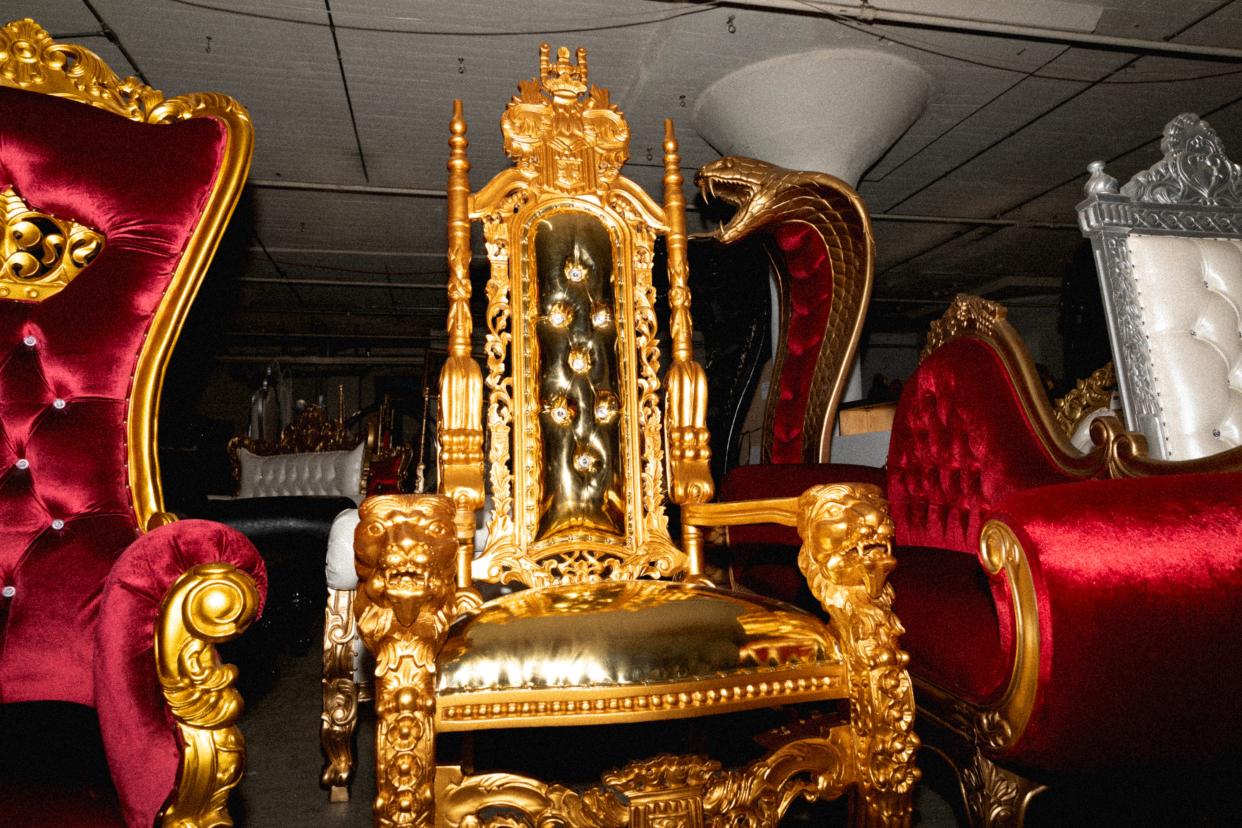
The scene unfurls like a mirage. I’m inside a photo studio, which is inside a 30,000-square-foot showroom—with overhead strip lights and chandeliers—seated opposite the furniture dealer Allen Kraiem, the kind of guy that could persuade me to buy a ShamWow at 3 a.m. My torso is dwarfed by the monumental throne I’m ensconced in, and Allen, also atop a throne (his, glossy and white; mine, the dusky sheen of a prize-winning mule) tells me, with a conspiratorial nod, that these thrones are bestsellers. Just beyond us lies a fantastical tableau: a vast, triumphant sea of 1,500 reproduction royal thrones, royal loveseats, and royal lounges, most of them with tags attached and ready to be shipped around the world. If I squint, their mass of gilded edges melts together at my periphery, as though the sea of seats has been squeezed inside a lavish frame. The only image that could compare, I decide, would involve some other uncanny immensity, say, 1,500 mall Santas or 1,500 kings.
It just so happens that both of those groups—Santas-for-hire and actual sovereign rulers—are returning customers at Throne Kingdom, the global throne retailer whose headquarters I’m visiting. Open to the public six days a week, Throne Kingdom HQ is located within Brooklyn Army Terminal, a beige business park that also hosts a waffle cone manufacturing plant, a chocolatier, and a medical devices company. I’m greeted at the entrance by Allen’s son, Sol—an eager throne dealer and heir to his father’s mass-market empire—and together we walk through aisles of towering seats, while Allen ricochets from call to call, doling out delivery rates.
First, we pass rows of the “Santa Reindeer Bench,” a velveteen throne-cum-wheelbarrow that’s wide enough for two. It’s flanked by gleaming reindeer, their antlers erect as finials, and at its apex are hand-carved initials: S.C., for you know who. Nearby, a sherbet-pink Sweethearts candy is reincarnated as a seat. Frozen lions guard a handsome coronation throne. A jet-black, jumbo chair turned scorpion curls theatrically over sitters; another covers them with a hooded canopy and looks like a Fabergé egg. Chaise longues, sold in multiple colorways, sport names like “Cleopatra” and “Zeus 80” and “Monaco”; others are odes to eminent monarchs through history: “King David” and “King Kong.” I spy a copy of the Game of Thrones Iron Throne, erupting with swords. It looks to be forged from metal but is actually whittled mahogany on wheels. My favorite throne is comically tall and svelte and upholstered in white stain-proof vinyl, like a cigarette crossed with a limousine. Later, examining my selfie atop it, I appear to be test-driving my future coffin.
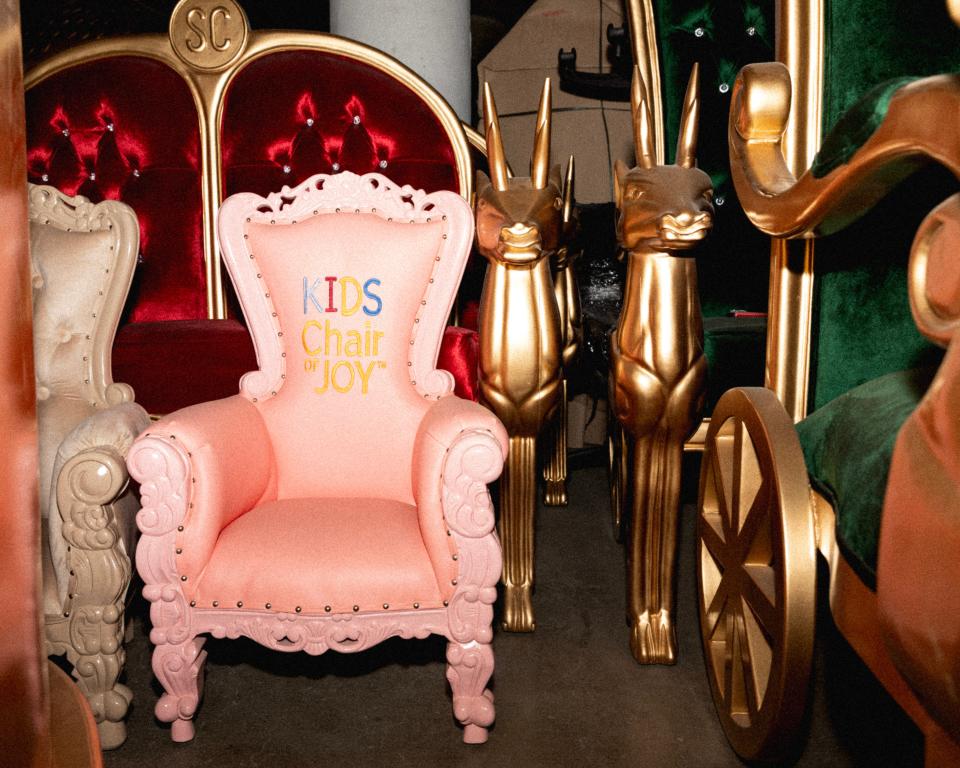
Unlike rocking chairs, whose see-saw function necessitates a particular form, thrones are not fixed objects. Specially made seats for dignitaries, monarchs, emissaries of god (and even gods themselves) were common across ancient cultures, and their design, materials, and dimensions vary wildly. The Ashanti Empire, ruling modern-day Ghana, used “Golden Stools” for thrones, which were low and backless and believed to have descended from the heavens. Made from a single block of wood and inlaid with gold, their crescent-shaped seats were strung with bells to warn of danger. Mughal emperor Shah Jahan replaced his father’s black basalt slab with a solid gold throne that reportedly cost him twice as much as the Taj Mahal, completed a few years later. Also backless, it was propped with cushions and surrounded with gem-studded columns, its canopy strung with pearls.
The majority of Throne Kingdom’s product has a similar visual vernacular, though almost anything is possible design-wise through their customization offerings. There’s usually a high, enclosing back and armrests; tufted cushioning in velvet or vinyl or faux patent leather; a solid-wood frame with decorous hand-carvings, painted gold or silver or white. Each chair is produced especially for the retailer by a handful of Indonesian manufacturers—carvers, upholsterers—including one they’ve known for 15 years. (Throne Kingdom chairs use toona sureni or suren toon, an Indonesian-grown wood native to the mahogany family.) Products are shipped straight from Brooklyn Army Terminal, where any final customizations occur, too, such as embroidery, logos, or special fabrications. Right now, they’re experimenting with embedding faux gemstones in frames for a commercial client. Sol lays the samples out before me, and we both turn them over in our palms: costume rubies of glittering cubic zirconia, as well as a budget-friendly option in glass.
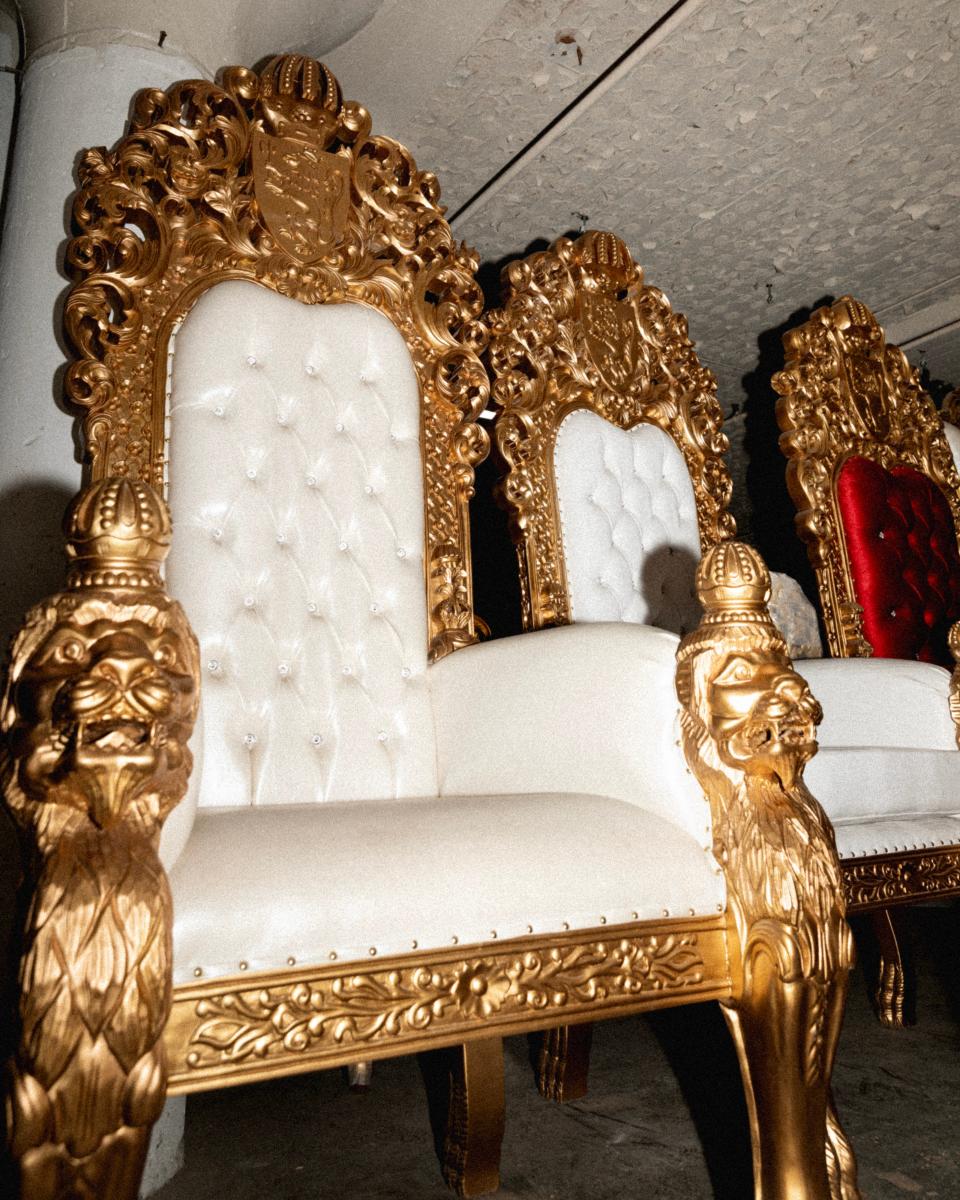
The cheapest seats of power on Throne Kingdom’s website cost $295. These are made for children and often bought in multiples—a throne for the whole family. (Pet thrones, I’m assured, are coming soon—Allen recently found himself moved by “the most beautiful furniture store for dogs in Florida,” and Sol has been commissioning designs.) Priced at just below $10,000, and shaped like an irate snake, King Cobra is among the kingdom’s most expensive—and heaviest—creations. Per the website, it’s “a work of art that tells a story of ancient mystique and modern luxury,” equally suited to “a grand palace, an exotic retreat, or a collector’s den.” A glossy, made-for-TV chair, hulkling and slightly goofy, it recalls both G.I. Joe’s Cobra Commander seat and WWE alum Santino “The Cobra” Marella, who undercut his own machismo with a sock-puppet snake schtick.
“Whoever sees King Cobra, wants it,” Allen says. “That is, if they have the space for it. We have a picture someone sent us of King Cobra in their home; the entire wall behind them is painted like the Pharaohs of Egypt. Even the King of Ghana took one of those already.”
Birth of a Kingdom
Allen wasn’t always peddling thrones, but he was always selling something. His father, an Egyptian migrant who arrived in New York in 1952, had a store on Fifth Avenue for many years, importing electronics, rugs, exotic furnishings, and antiques from Asia and Africa. The space was organized into multiple store-in-stores, each manned by separate salespeople. At one counter, a guy would help you with Ray-Ban sunglasses, at the next, you could find Parker and Montblanc pens, or the latest Nikon cameras. Allen started working there after school, from age 14, taking shifts until 10 p.m. He worked the floor downstairs, selling genuine Persian rugs. “My father taught me the importance of being nice, being patient in sales,” he says. “Words are very important. If you want to be mad, you’ve got to be a sweet talker as well. When you’re a positive person, everyone wants to be [your] friend.” By the age of 16, his knack for salesmanship was paying off: He bought himself a light blue corvette, and traversed between school and the store in it.
Allen’s first import trip, made at the request of his father, was to Canton Fair in Guangzhou, China’s oldest and largest trade fair. Soon, he was jetting frequently between New York, Hong Kong, and China. “We didn’t even have a warehouse. We’d bring everything straight to the store. And we’d be selling so fast because the prices got better.”
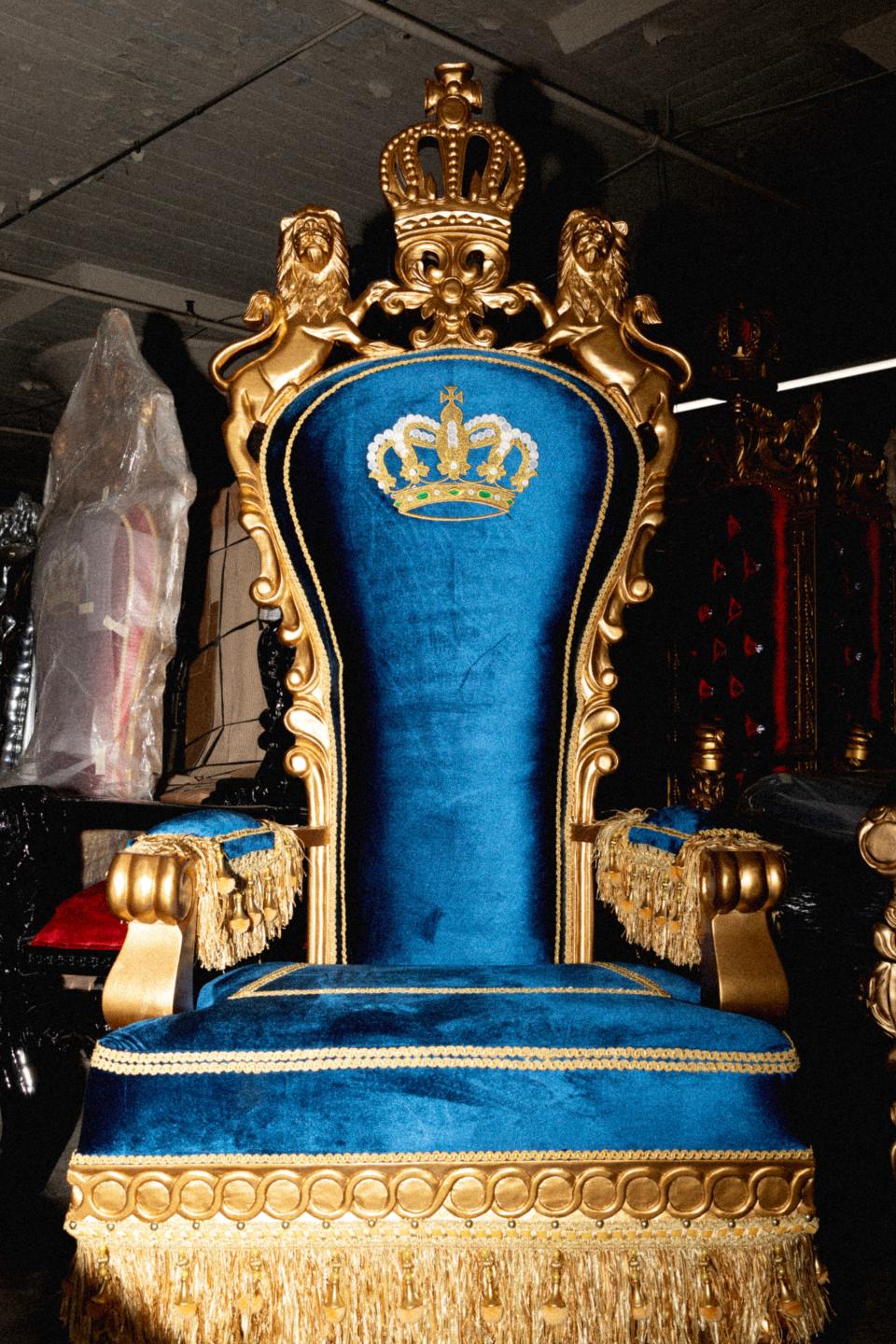
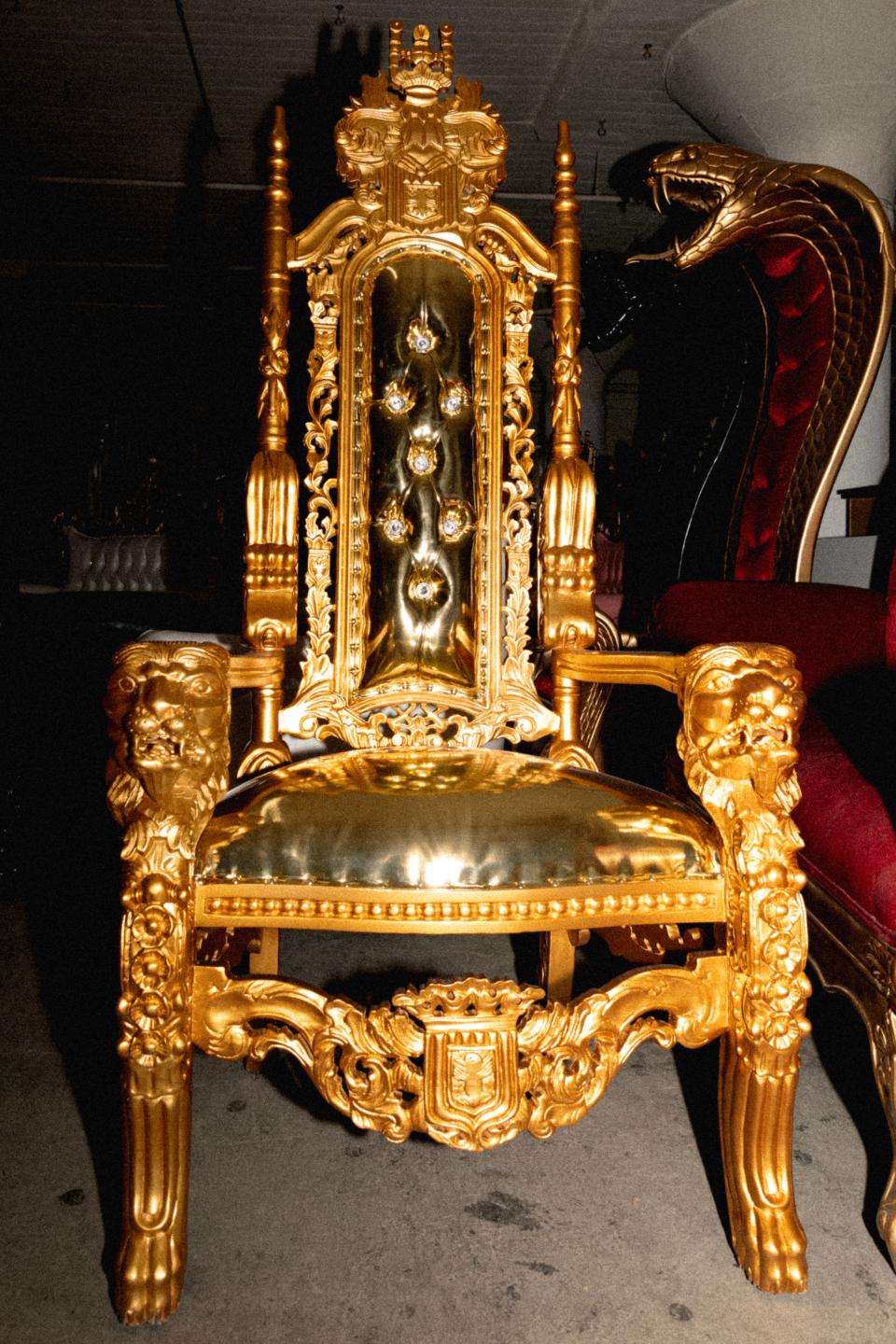
Eventually, Allen launched his own business, Best Home Decorators, Inc. in 2012. He hired staff, including three of his children and two cousins. For years, he imported the kind of furnishings that tantalize magpie-eyed travelers on long, empty highways: Chippendale desks, rococo beds, old-world tapestries, chandeliers, and marble lions. And then one day in 2018, following the advice of his Internet-savvy son, Allen made a sudden, company-wide announcement. Best Home Decorators would be abandoning its name; in fact, they’d be changing a lot of things. From now on, they’d be known as Throne Kingdom, sellers of lifesize thrones.
“We’re not paying a retail wholesaler anymore,” Allen explains. “We became a manufacturer, and we can offer better prices.” His employees reached out to existing customers, pitching thrones at competitive rates. According to Sol, a lot of them were buying. “The home furniture market—especially this area [of Brooklyn]—had been so saturated,” he says. “Before, we’d work so hard, showing people around for two or three hours, and if we didn’t sell them on the spot, they’d never come back. I saw the thrones and thought, Hey, we could be selling these. We wouldn’t be competing with anybody. I knew it would be harder to build our brand, but eventually, we’d be working less to make more.”
In 2023, Throne Kingdom generated roughly $2.4 million in revenue, a 10% increase on the previous year. They now deliver to every state in America and beyond—to Australia, Nigeria, Saudi Arabia. Their biggest spike in sales occurred during the pandemic, when event rental companies, bolstered by government grants, began buying up their first “fleets” of thrones. These supplied a growing market of customers self-styling their life’s major celebrations—weddings, baby showers, graduations, quinceañeras—for audiences viewing at a distance or driving by. “We bring everybody’s dream into fruition, ” Allen says. “Most people think we’re crazy. Even if you’re selling toothpicks, they’ll say you’re crazy! So you don’t listen to nobody. You just go about your business.”
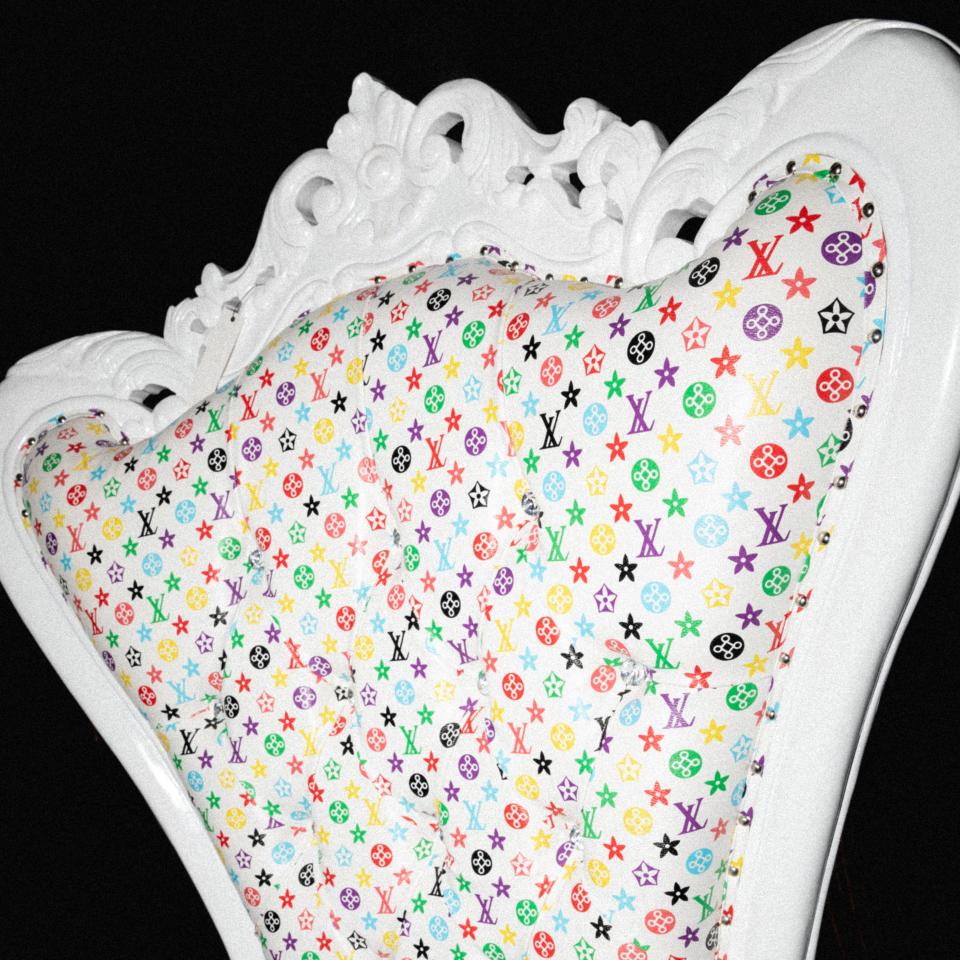
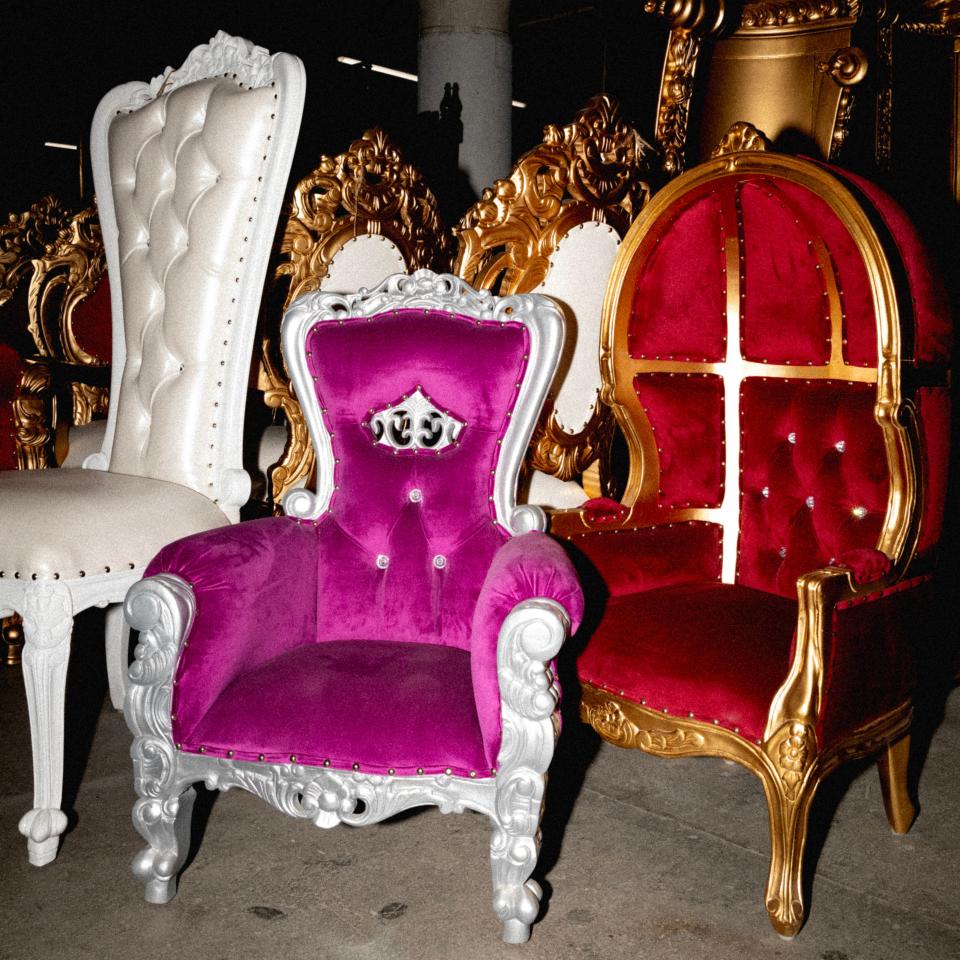
Scammers and Saviors
The custom gray suit Allen is wearing, a gift from his son, is lined with e-comm images of throne chairs. They repeat across the silk like a luxury brand logo-mark, riffing on codes of legitimacy and desire. Like many salespeople, Allen is prone to optimistic hyperbole, but at the center of it all is something gleaming, maybe even a little true. “Everybody wants to be a king,” he says, matter-of-factly. “It doesn’t matter where they live, they want to own a throne chair.”
Allen’s favorite anecdotes involve his customers eclipsing the ordinary limits of longing (essentially, going nuts for thrones). Take this one: When delivering the glitzy King Samuel to the home of a journalist in Brooklyn, it became apparent that the seat wouldn’t fit through the front door. “He told me, ‘I don’t like my doorway anyway,’” Allen recalls. “Then he took a crowbar, and started ripping his door off. He tore the entire front door and frame away, and we carried the chair straight in…. You see how much people want a throne chair?”
He’s thrilled when shoppers visit the showroom in person, often quizzing them on the length of their journey. “I ask, ‘How far did you drive?’ We’ve had people driving eight hours from Maine, or 26 hours from Texas,” he says. “Someone drove 10 hours from South Carolina on an empty school bus—they filled it with chairs, then drove 10 hours back home.” The dedication of these shopping road trips (and driving literal days for thrones) is partially due to a determination not to be ripped off twice. According to Allen, the throne market is riddled with fake retailer scams. Noble-seeming chairs are sold online, only to never ship. “The scammers keep them excited. They say, ‘It’s coming.’ Then, ‘It came scratched, I’ll get you a new one. Wait another month.’ And when the buyer calls the bank, after three months they say they can’t help them…. The scammers are selling under seven different names. And people often think that there’s seven options, or seven prices, or that you should trust all those people over some guy in New York.”
It’s worth noting that Throne Kingdom is not immune to disappointing customers: A handful of negative reviews, mostly on Yelp, complain of poor-quality paint jobs, broken arrivals, and in one case, ineffective third-party delivery which left the commenter suspicious and out of pocket. “They do legit business sometimes,” accused the infuriated party, “but [will] steal whenever they can.”
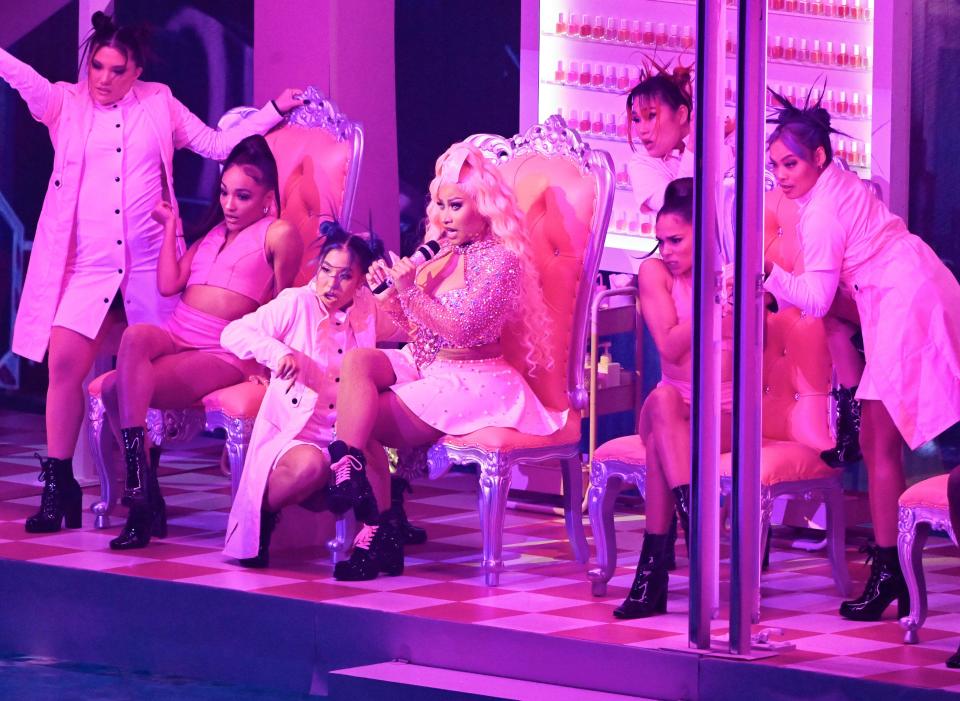
August 28th, 2022. Newark, USA.Nicki Minaj on stage at the 2022 MTV Video Music Awards, Prudential Centre, Newark. Credit: Doug Peters/EMPICS/Alamy Live News
Live Streaming the Throne
“A Queen on her throne is a woman who has mastered herself.
She’s not perfect, but she is complete.”
—Paris Hilton on Instagram, November 10, 2018
Last December, to promote her new album, Pink Friday 2, Nicki Minaj joined fellow New Yorker Kai Cenat for a live stream on Twitch. In clips of the event—which broke Kai’s single-stream viewership record—she presides over a crystal-studded wingback throne, Polly Pocket–pink and fresh out of the UPS box. (“Queen shit,” Kai beamed at the oversized seat, dragging it across his leopard-print carpeting on live.)
Throughout the stream, the throne expands Nicki’s physical and psychic presence. No matter that she arrives at 3 a.m.—four hours behind schedule—the bubblegum colossus is her stand-in. An ancient beacon of divinity, it assures sleepy fans her tardiness is justified: After all, Nicki is a star, the queen of rap, and queens have things to do. The high backrest augments her physicality, so that even seated in the middle distance, her torso commands the full height of the frame. The object thrums, to paraphrase the critic Dave Hickey on Liberace, with an ersatz spiritual dazzle. Nicki holds court on it, then co-opts its plush, bedazzled body for comedic effect, and as an act of ownership: twerking on its phony royal arms, draping her body cutely over the cushioning, leaning into it with mock self-importance. Before she leaves, she autographs the throne’s upper corner—permanently remaking it in her image—and tells Kai his future guests can sit in it for good luck.
While Throne Kingdom could not confirm if this model came from their warehouse, they’ve worked with Nicki before: Their classic Valentina features in her 2022 VMAs performance. In fact, her live shows and music videos are littered with thrones, thrust into symbolic setups that flitter between self-serious and parodic. Her use of them builds on a niche-but-mighty canon of musicians leveraging royal seating to convey their ascendance, power, the loneliness of the top: Biggie on his stately wood monk bench; Michael Jackson on a too-big crimson-cushioned throne, its frame ecstatically bursting outwards like the golden gates at Versailles; even Funkadelic, Al Green, Dolly Parton, and Misty Blue, whose 1970s album covers all featured the rattan peacock chair popularized by Black Panther Huey P. Newton.
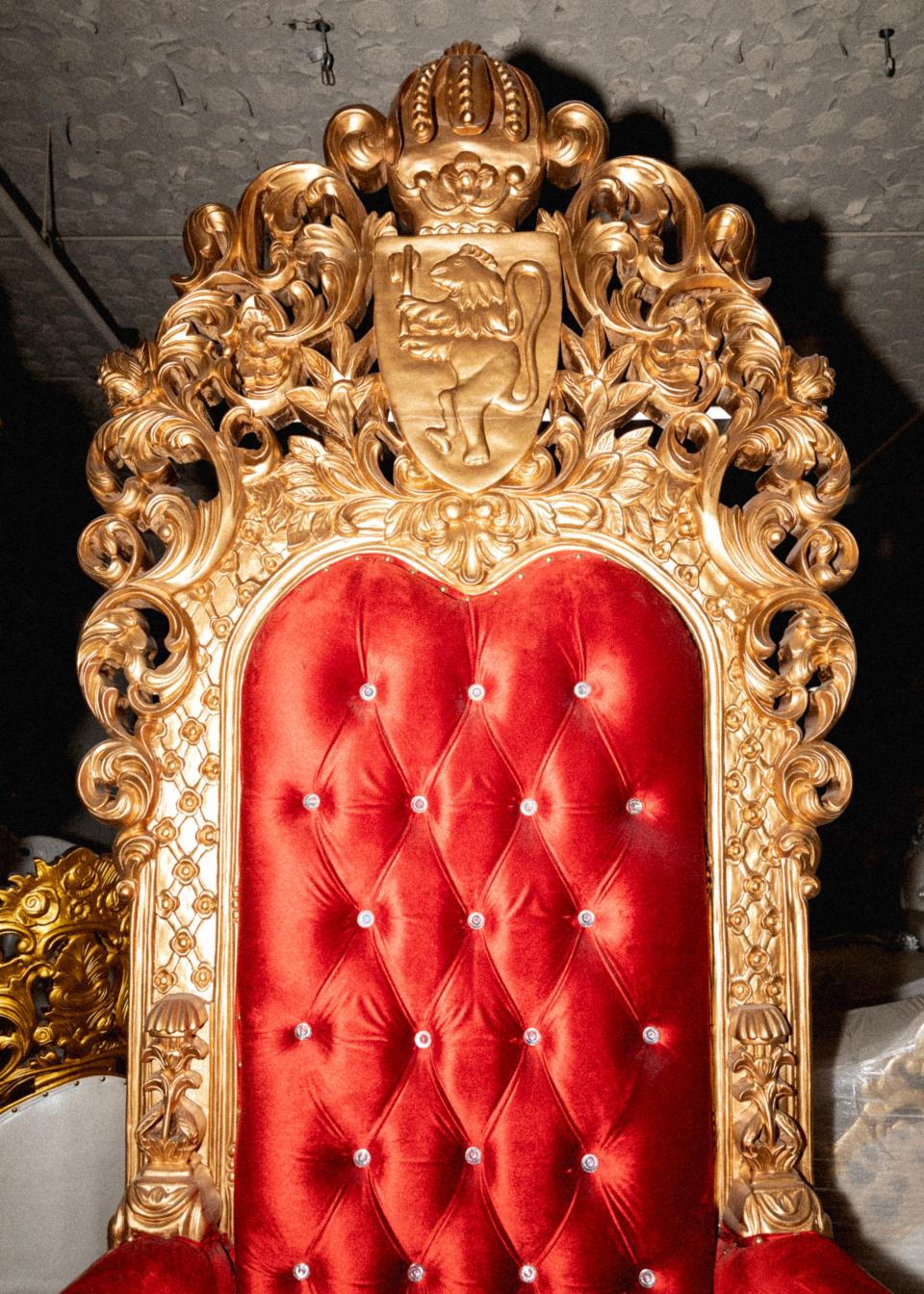
Redefining Royalty
Who precisely is buying up Throne Kingdom stock, besides music video set designers and Ghanaian royalty and journalists who hate their doors? For starters, there’s new-money athletes and celebrities with a proclivity for kitsch grandeur, for whom the throne—with its exaggerated proportions and lofty symbolism—is a canny self-promotional tool. There is Ryan Garcia, the champion UFC fighter and rightwing conspiracy theorist, who’s installed multiple thrones inside his home and at press conference tables, and who sometimes dons a jubilant crown post-fight. There is Liver King, a souped-up Houston fitness influencer and “Barbarian elite,” who advocates for the daily consumption of unprocessed organs and meat, and who once ordered 13 thrones over FaceTime, which he now poses with online. (“He bought all the crazy looking chairs,” says Allen, “He wanted every one.”) The Queen of Versailles has Throne Kingdom chairs, as does musician Ozzy Ozbourne and two Bravo housewives: Real Housewives of Utah’s Mary Cosby, whose rainbow-striped Queen Tiffany thrones recall a Museum of Ice Cream exhibit; and New Jersey’s Jennifer Aydin, self-dubbed “The Queen of Thrones,” whose nine-bedroom McMansion in Paramus includes at least 15 regal perches, mostly in cream and gold.
In spite of their distinct exaggerations, throne chairs seem to straddle markets, economic class, and, seemingly, aesthetic proclivities. (At one point, Allen says space has little bearing on the ambitiousness of a client’s purchase: “The smaller the house, the bigger the throne.”) Around 60% of Throne Kingdom’s business arrives from other businesses: casinos, cruise ships, churches, hairdressers, nail salons, decorators, photo studios, bridal boutiques, podcasters, theaters, and nightclubs. They’ve sold thrones to the Houston Astros and Colorado Buffaloes; to Inked Tattoo Salon (an offshoot of the magazine); to Blood Manor (New York’s premier haunted attraction); to “pretty much all the palm readers in New York,” and to, obviously, “a lot of goths.”
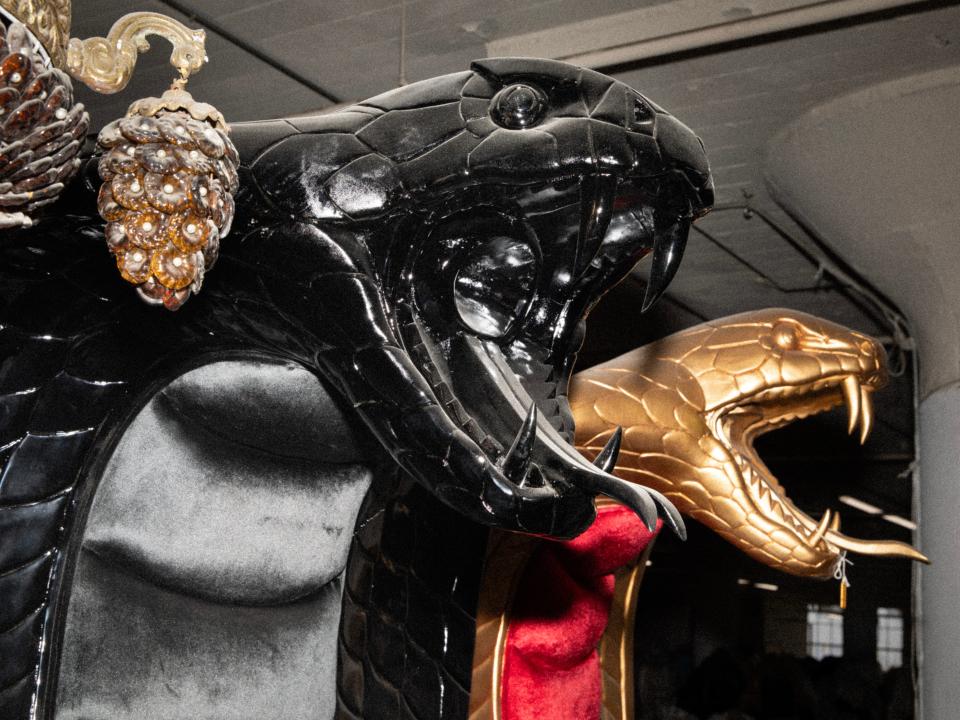
Tonya Edinger, founder of Events & Weddings in Pittsburgh (and proud owner of one purple velvet throne) tells me her clients love the Queen Tiffany series, with its pretty border carvings of curling rococo leaves and scrolls. “It’s a specific look that reminds me of that Jackie Kennedy, Audrey Hepburn-class,” she says. I ask her where, mid-wedding, a throne might make a cameo. She explains her team usually sets a pair up at the sweetheart table, a small reception table just for the newlyweds, where they can be the center of attention. Tonya asks, “What couple wouldn’t want to be royalty on their special day?”
Sheryl Lyn, a Las Vegas–based entrepreneur and founder of self-improvement and mindfulness organization Joyely, began centralizing thrones in her programming a year ago. They are used less as a means of being noticed by others, but for paying more attention to oneself. Via the “Chair of Joy® Experience Methodology”—based on a children’s book she co-authored, Chair of Joy—she encourages kids of all ages to take time out on a special seat, where they can wholly embrace their emotions and develop accountability for their own joy. (Her corporate adult program now uses a white diamond-studded wingback throne too.)
Sheryl was drawn to the “grandeur, recognizability, and symbolic resonance” of the throne silhouette and its subtle diversionary abilities, “gently shifting attention away from disruptive behaviors to a more positive focus.” She gives an example of the throne as a catalyst for behavioral-emotional transitions, where a teacher—in a Chair of Joy–partnered classroom—had noticed one student becoming agitated and fatigued. “Instead of reprimanding, the teacher gently suggested they visit the Chair of Joy,” Sheryl says. “As the child sat [there], they engaged in deep breathing and visualized enjoyable activities, like playing outside with their dog. This brief mental break allowed the child to return to their tasks, refreshed and ready to learn.” Sheryl’s ambitions are lofty—she’d like every child, wherever they live, to be gifted a Chair of Joy at birth, not just for comfort but “as a tangible reminder of their inherent capacity for joy and resilience.”
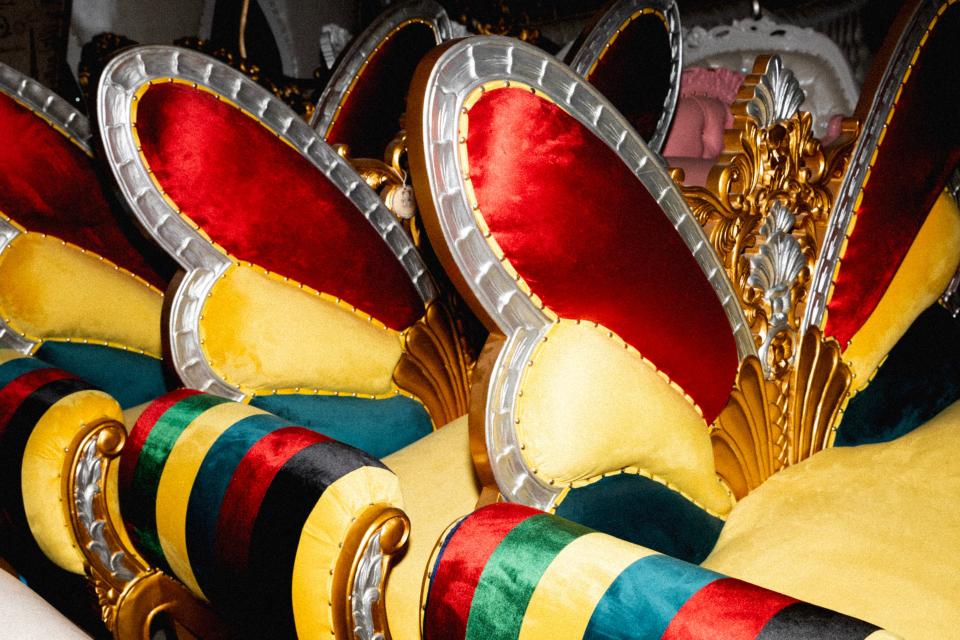
The Great American Dream Chair
For a nation without royals, the “reproduction” throne manages to feel like an utterly American object (I use scare quotes here, as there is no single referent being reproduced, just the quality of a non-original). With its talismanic, novelty appeal, its existence—and success—seems to embody the idea that traditional symbols of power are less precious than we imagine them to be, and that equally, those symbols are ours to claim, if only we desire and buy them. In Baudrillard’s America, the postmodernist frames theatricality—and an awareness of the cinematic gaze—as core to the mythic banality, dream quality and grandeur of the American way of life. “In America, cinema is true because it is the whole of space, the whole way of life that are cinematic.”
I ask Evan Snyderman of New York design and art gallery R&Company how replica thrones fit into a broader design context—something he finds “almost ludicrous, outrageous to a degree.” He notes the trickiness of quantifying what a throne actually is: “People have long aligned to the idea of a throne to power of course. Would an executive chair behind a massive desk be considered a throne?” Generally speaking, he says that high back chairs have played a significant role in furniture design history “as an accent piece, something to put by a sideboard or console.” Evan sends me examples by artists he’s worked with over the years, including Wendy Maruyama’s Mickey Mackintosh chair, whose elongated back is topped with cartoonish, Memphis-inflected Disney mouse ears. He adds, “What I find interesting is that the high back chair offers some sense of humor, at least in my opinion. It’s almost making fun of a typical chair.”
Critic Philippa Snow, whose new book, Trophy Lives, argues that particularly successful celebrities could be considered self-authored artworks, says throne ownership among adults might say more about desire than reality. “Would a celebrity who is so much a celebrity that their starriness feels almost divine—i.e. someone like Beyonce—have a throne in their house?” she asks. “I can't really picture it. It’s sort of like the noughties trend for buying sweatpants with ‘SEXY’ written across the ass. If you have to say it, you know?”
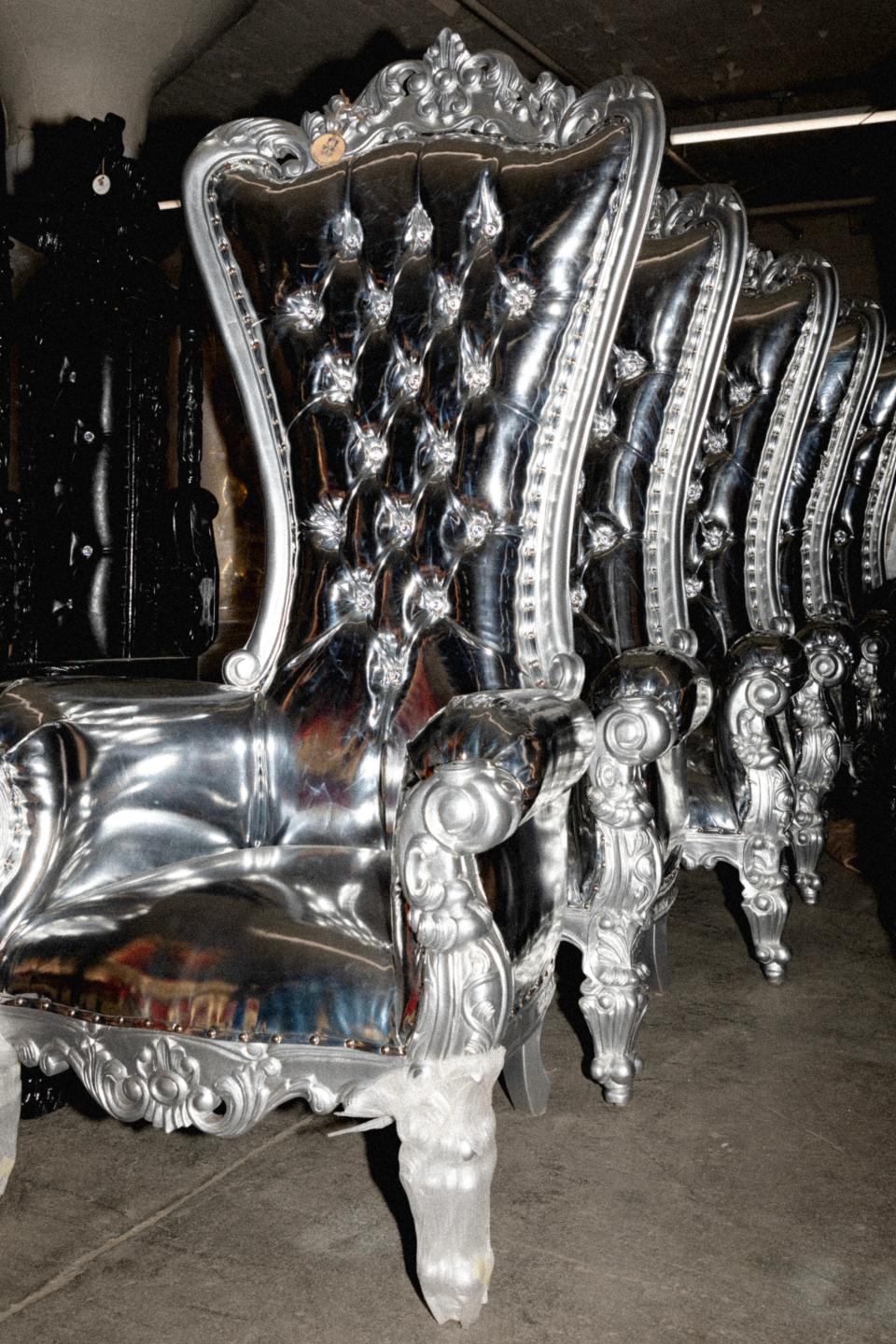
We are making one last lap of the kingdom, Allen and I. Around us, gold frames twinkle under stark artificial light, like a promise you can wrap your arms around. Allen is talking rapidly about weddings (which he loves) and wedding crashing (which he also loves and shows me the videos to prove it). He’s also talking about thrones, because all roads lead to Throne Kingdom. For every wedding he attends as a guest, Allen delivers a few thrones to the venue for photos. “The guests love them,” he exclaims while turning down an aisle. “They go crazy! They’ve never seen anything like them.” In his own home, at the head of the dinner table between tall silver chairs covered in “a shiny blue plastic,” Allen has a permanent throne of his own, white-on-white and pure as snow. Nearby, he says, are mini thrones for all the grandkids.
Mid-stroll, somewhere up the back of the showroom, I lose Allen to a potential sale. Three roommates in their early 20s that happen to live in the neighborhood have stumbled upon Throne Kingdom on Google maps and wandered over. They are taking covert selfies and muffling giggles when we find them; it seems immediately clear they do not wish to actually buy a throne. But Allen doesn’t notice, or he doesn’t mind, or maybe here, in this golden warehouse, it really is possible to convert anyone into purchasing a piece of pseudo-royalty, because I watch as he sits the friends down—at a little conference of thrones—to take them through financing options. “Once, everybody had cloth diapers,” says Allen. “Now, the whole world’s using Pampers. It’s the same thing: Once everybody used regular chairs. Now everybody wants a throne chair.”
Originally Appeared on Architectural Digest

